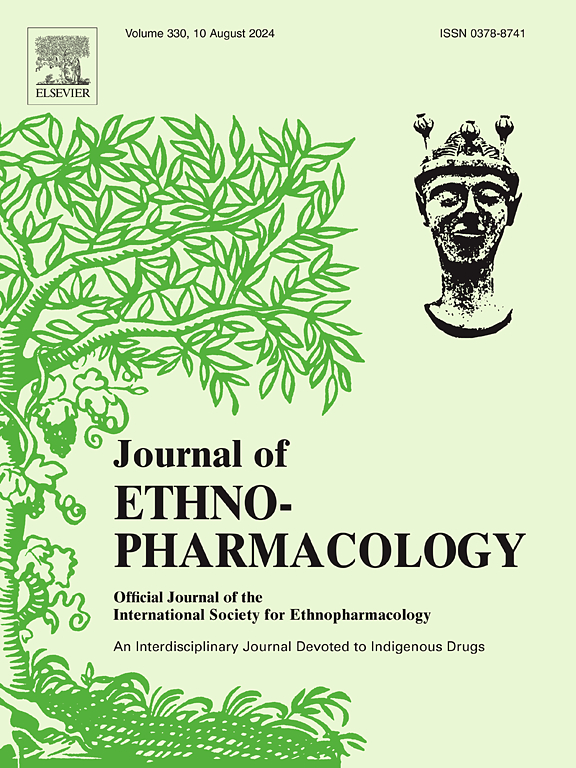Mechanism of action of Pulsatilla chinensis (Bunge) Regel compounds in hepatocellular carcinoma (HCC) treatment: An integrated analysis combining network pharmacology, molecular docking, molecular dynamics simulations and luciferase reporter gene assay
IF 5.4
2区 医学
Q1 CHEMISTRY, MEDICINAL
引用次数: 0
Abstract
Ethnopharmacological relevance
Hepatocellular carcinoma (HCC) is a primary malignancy originating from hepatocytes in the liver parenchyma. Pulsatilla chinensis (Bunge) Regel(P. chinensis) (verified via http://www.theplantlist.org, accessed April 5, 2025), a perennial herb of the Ranunculaceae family, contains multiple bioactive constituents with demonstrated pharmacological effects, including antitumor, anti-inflammatory, antibacterial, antiviral, and immunomodulatory activities.
Aim of the study
To investigate the mechanisms of action and pharmacodynamic material basis of active compounds from P. chinensis against HCC cells.
Materials and methods
Active compounds of P. chinensis were screened using the HERB database. Potential drug targets were predicted via the SwissTargetPrediction database. HCC-related targets were retrieved from GeneCards, OMIM, and TTD databases, followed by Venn diagram analysis to identify shared drug-disease targets. STRING database was employed for protein-protein interaction (PPI) network analysis and core target screening. DAVID platform was used for Gene Ontology (GO) enrichment and Kyoto Encyclopedia of Genes and Genomes (KEGG) pathway analysis. Cytoscape software constructed a compound-target-pathway network to identify key active components and potential mechanisms. Molecular docking simulations validated the binding affinity between core targets and Pulsatilla's active compounds. A luciferase reporter gene system was established, generating A549-TP53 monoclonal cell lines stably expressing p53-NLuc, followed by functional validation. Traditional Chinese medicine (TCM) monomer compounds were screened using A549-TP53 cells. Flow cytometry and Western blot assessed their effects on apoptosis in 7402 and 7721 human HCC cells. Molecular dynamics simulations validated the binding interactions between the compounds and TP53.
Results
HERB database identified 29 active compounds from P. chinensis. SwissTargetPrediction predicted 606 potential drug targets. GeneCards, OMIM, and TTD yielded 1095 disease-related targets, with 163 overlapping targets identified via Venn analysis. PPI analysis using the STRING database revealed the top five core targets: TP53, GAPDH, AKT1, EGFR, and STAT3. Cytoscape analysis identified 14 core active compounds from P. chinensis. Molecular docking results revealed that among these 14 core active compounds from P. chinensis, the top five with the highest binding affinity to TP53 protein were: Pulchinenoside C, Pulsatilla Saponin D, Pulsatilloside B, Qingdainone and Sitogluside. The recombinant retroviral vector pQCXIP-p53-NLuc was successfully constructed, and luciferase activity assays confirmed A549-TP53 as a stable NanoLuc (Nluc)-expressing cell line regulated by TP53. Luciferase assays demonstrated that Pulchinenoside C (20–80 μM), Pulsatilla Saponin D (5–80 μM), and Qingdainone (20–80 μM) significantly modulated A549-TP53 transcriptional activity. Flow cytometry revealed that Pulsatilla Saponin D and Pulchinenoside C markedly induced apoptosis in 7402 and 7721 cells.Western blot revealed Pulchinenoside C significantly elevated cleaved caspase-3 in both 7402 and 7721 cells, whereas Pulsatilla Saponin D markedly increased it in 7402 cells. Molecular dynamics simulation results indicate that Pulsatilla Saponin D and Pulchinenoside C may exert their biological effects by inhibiting the TP53 target protein.
Conclusion
The active compounds Pulchinenoside C and Pulsatilla Saponin D significantly promoting apoptosis in HCC cells via TP53 targeting.

白头草(白头草)凝胶类化合物治疗肝细胞癌的作用机制:结合网络药理学、分子对接、分子动力学模拟和荧光素酶报告基因检测的综合分析
民族药理学相关性:肝细胞癌(HCC)是一种起源于肝实质内肝细胞的原发性恶性肿瘤。白头翁(白头翁)chinensis)(通过http://www.theplantlist.org验证,于2025年4月5日获得)是毛茛科的多年生草本植物,含有多种生物活性成分,具有药理作用,包括抗肿瘤,抗炎,抗菌,抗病毒和免疫调节活性。研究目的:探讨紫草中活性成分对肝癌细胞的作用机制和药效物质基础。材料与方法:从中药数据库中筛选有效成分。通过SwissTargetPrediction数据库预测潜在的药物靶点。从GeneCards、OMIM和TTD数据库中检索hcc相关靶点,然后进行维恩图分析以确定共享的药物-疾病靶点。采用STRING数据库进行蛋白-蛋白相互作用(PPI)网络分析和核心靶点筛选。使用DAVID平台进行基因本体(GO)富集和京都基因与基因组百科全书(KEGG)通路分析。Cytoscape软件构建了一个化合物-靶标-通路网络来识别关键的活性成分和潜在的机制。分子对接模拟验证了核心靶点与白头翁活性化合物之间的结合亲和力。建立荧光素酶报告基因体系,生成稳定表达p53-NLuc的A549-TP53单克隆细胞系,并进行功能验证。利用A549-TP53细胞筛选中药单体化合物。流式细胞术和Western blot检测其对7402和7721人肝癌细胞凋亡的影响。分子动力学模拟验证了化合物与TP53之间的结合相互作用。结果:中药数据库共鉴定出29种有效成分。SwissTargetPrediction预测了606个潜在的药物靶点。GeneCards、OMIM和TTD产生了1095个与疾病相关的靶点,其中163个通过维恩分析确定了重叠靶点。使用STRING数据库的PPI分析揭示了前五个核心靶点:TP53、GAPDH、AKT1、EGFR和STAT3。细胞景观分析鉴定出14种主要活性成分。分子对接结果显示,与TP53蛋白结合亲和力最高的14种核心活性物质分别为白杨皂苷C、白杨皂苷D、白杨皂苷B、青丹酮和西奥格苷。成功构建了重组逆转录病毒载体pqcxiip -p53- Nluc,荧光素酶活性测定证实A549-TP53是一个稳定的NanoLuc (Nluc)表达细胞系,受TP53调控。荧光素酶实验表明,白头翁皂苷C (20-80μM)、白头翁皂苷D (5-80μM)和青丹酮(20-80μM)可显著调节A549-TP53的转录活性。流式细胞术显示白头翁皂苷D和白头翁皂苷C显著诱导7402和7721细胞凋亡。Western blot结果显示,pulchinen皂苷C在7402和7721细胞中显著升高了cleaved - caspase-3,而白头草皂苷D在7402细胞中显著升高了caspase-3。分子动力学模拟结果表明,白头翁皂苷D和白头翁皂苷C可能通过抑制TP53靶蛋白发挥其生物学作用。结论:白头翁皂苷C和白头翁皂苷D可通过TP53靶向作用促进肝癌细胞凋亡。
本文章由计算机程序翻译,如有差异,请以英文原文为准。
求助全文
约1分钟内获得全文
求助全文
来源期刊

Journal of ethnopharmacology
医学-全科医学与补充医学
CiteScore
10.30
自引率
5.60%
发文量
967
审稿时长
77 days
期刊介绍:
The Journal of Ethnopharmacology is dedicated to the exchange of information and understandings about people''s use of plants, fungi, animals, microorganisms and minerals and their biological and pharmacological effects based on the principles established through international conventions. Early people confronted with illness and disease, discovered a wealth of useful therapeutic agents in the plant and animal kingdoms. The empirical knowledge of these medicinal substances and their toxic potential was passed on by oral tradition and sometimes recorded in herbals and other texts on materia medica. Many valuable drugs of today (e.g., atropine, ephedrine, tubocurarine, digoxin, reserpine) came into use through the study of indigenous remedies. Chemists continue to use plant-derived drugs (e.g., morphine, taxol, physostigmine, quinidine, emetine) as prototypes in their attempts to develop more effective and less toxic medicinals.
 求助内容:
求助内容: 应助结果提醒方式:
应助结果提醒方式:


